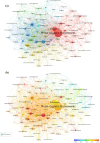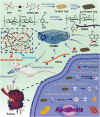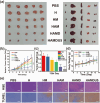Research prospects and AI-driven strategies for metal-organic framework-hydrogel composite materials in cancer treatment
- PMID: 40395219
- PMCID: PMC12086447
- DOI: 10.1039/d5md00207a
Research prospects and AI-driven strategies for metal-organic framework-hydrogel composite materials in cancer treatment
Abstract
Metal-organic frameworks (MOFs) as emerging materials with highly tunable structures, large specific surface areas, and abundant pores show unique advantages in gas storage, catalysis, and drug delivery. Hydrogels are a class of materials consisting of polymers or small molecules that can trap a large amount of water and are thus widely used in biomedical applications owing to their high water content, good biocompatibility, biotissue-like softness and elasticity, and low immunogenicity. Consequently, composite materials formed by combining MOFs with hydrogels have been rapidly developed for cancer therapy. We have carried out considerable work on this type of composite material, exploring various combinations and investigating different treatment modalities, such as chemotherapy, immunotherapy, targeted therapy and combination therapy. Particularly, artificial intelligence (AI) technology was employed to characterize and enhance the therapeutic efficacy of the materials. This review first introduces the basic properties of MOFs and hydrogels and the role played by AI technology in their development. Subsequently, we describe the types, characteristics, applications, and challenges of MOF-hydrogel combinations, focusing on the research progress of various types of cancer treatments based on MOF hydrogels and the application of AI technology in this field. With the deepening of research, the development of smarter and more efficient MOF-hydrogel materials and the in-depth exploration of the application of AI technology in cancer therapy are expected to realize the precise treatment and effective control of cancer and bring new hope to cancer patients.
This journal is © The Royal Society of Chemistry.
Conflict of interest statement
There are no competing interests.
Figures



















Similar articles
-
Biomedically-relevant metal organic framework-hydrogel composites.Biomater Sci. 2023 Apr 11;11(8):2661-2677. doi: 10.1039/d2bm01906j. Biomater Sci. 2023. PMID: 36810436 Review.
-
[One-step rapid enrichment and detection of malachite green in aquaculture water based on metal-organic framework hydrogel].Se Pu. 2022 Aug;40(8):721-729. doi: 10.3724/SP.J.1123.2022.04019. Se Pu. 2022. PMID: 35903839 Free PMC article. Chinese.
-
[Synthesis of porous organic framework materials based on deep eutectic solvents and their application in solid-phase extraction].Se Pu. 2023 Oct;41(10):901-910. doi: 10.3724/SP.J.1123.2023.08025. Se Pu. 2023. PMID: 37875412 Free PMC article. Chinese.
-
Metal-Organic Frameworks for Biomedical Applications.Small. 2020 Mar;16(10):e1906846. doi: 10.1002/smll.201906846. Epub 2020 Feb 6. Small. 2020. PMID: 32026590 Review.
-
[Application of gas chromatography separation based on metal-organic framework material as stationary phase].Se Pu. 2021 Jan;39(1):57-68. doi: 10.3724/SP.J.1123.2020.06028. Se Pu. 2021. PMID: 34227359 Free PMC article. Chinese.
References
-
- Bray F. Laversanne M. Sung H. Ferlay J. Siegel R. L. Soerjomataram I. Jemal A. Ca-Cancer J. Clin. 2024;74(3):229–263. - PubMed
-
- He Q. T. Qian P. Yang X. Y. Kuang Q. Lin Y. T. Yi W. Tian T. Cai Y. P. Hong X. J. Chem. Eng. J. 2024;493:152760.
- Peng G. Tisch U. Adams O. Hakim M. Shehada N. Broza Y. Y. Billan S. Abdah-Bortnyak R. Kuten A. Haick H. Nat. Nanotechnol. 2009;4:669–673. - PubMed
-
- Pettinari C. Pettinari R. Di Nicola C. Tombesi A. Scuri S. Marchetti F. Coord. Chem. Rev. 2021;446:214121.
- Akhtar-Danesh G. G. Finley C. Akhtar-Danesh N. Pancreatology. 2016;16:259–265. - PubMed
- Yamakawa K. Ye J. Nakano-Narusawa Y. Matsuda Y. Cancers. 2021;13:686. - PMC - PubMed
- Halbrook C. J. Lyssiotis C. A. di Magliano M. P. Maitra A. Cell. 2023;186:1729–1754. - PMC - PubMed
-
- Coluccia M. Parisse V. Guglielmi P. Giannini G. Secci D. Eur. J. Med. Chem. 2022;244:114801. - PubMed
- Qin L. Li Y. Ma D. Y. Liang F. L. Chen L. D. Xie C. Y. Lin J. Y. Pan Y. N. Li G. Z. Chen F. R. Xu P. R. Hong C. L. Zhu J. X. J. Solid State Chem. 2022;312:123175.
- Horcajada P. Chalati T. Serre C. Gillet B. Sebrie C. Baati T. Eubank J. F. Heurtaux D. Clayette P. Kreuz C. Chang J. S. Nat. Mater. 2010;9:172–178. - PubMed
- Zhao Z. Wu Y. Liang X. Liu J. Luo Y. Zhang Y. Li T. Liu C. Luo X. Chen J. Wang Y. Wang S. Wu T. Zhang S. Yang D. Li W. Yan J. Ke Z. Luo F. Adv. Sci. 2023;10:2303872.
-
- Zhong X. F. Sun X. Acta Pharmacol. Sin. 2020;41:928–935. - PMC - PubMed
- Liang F. Qin L. Xu J. Li S. Luo C. Huan H. Ma D. Li Z. Xu J. J. Solid State Chem. 2020;289:121544.
- Wang J. Ma D. Liao W. Li S. Huang M. Liu H. Wang Y. Xie R. Xu J. CrystEngComm. 2017;19:5244.
- Zhang T. Sun Y. Cao J. Luo J. Wang J. Jiang Z. Huang P. J. Nanobiotechnol. 2021;19:1–14. - PMC - PubMed
Publication types
LinkOut - more resources
Full Text Sources

